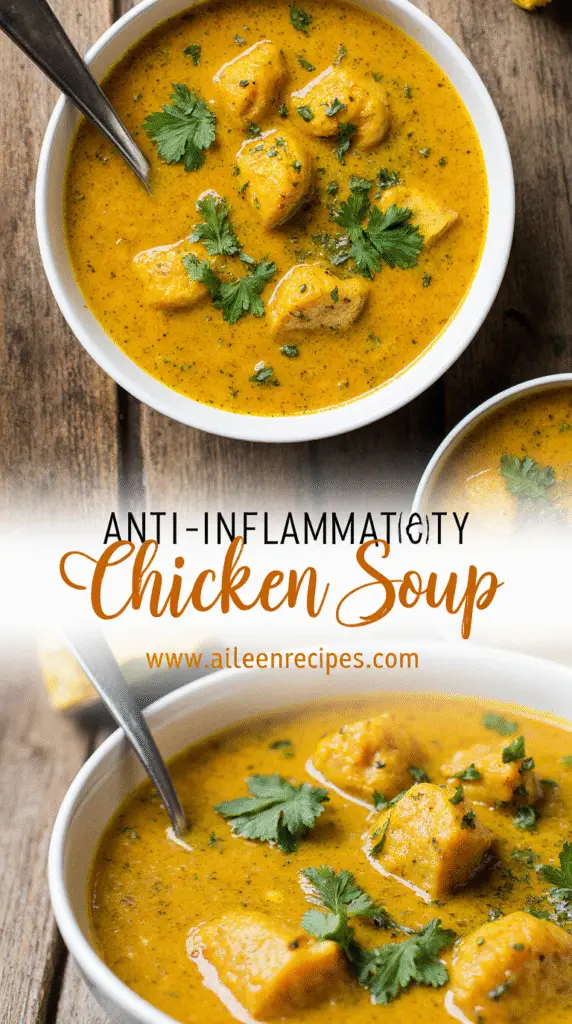How to Make Anti-Inflammatory Turmeric Chicken Soup: A Doctor-Approved Recipe
Did you know our anti-inflammatory turmeric chicken soup combines centuries of traditional healing wisdom with modern nutritional science? Surprisingly, this golden elixir does more than just taste delicious – it actively helps combat inflammation throughout your body.
When I’m feeling under the weather or noticing joint discomfort, I turn to this anti-inflammatory chicken soup recipe time and again. This healing chicken soup with ginger and turmeric has been endorsed by numerous healthcare professionals because it works. The turmeric ginger chicken soup combination creates a powerful one-two punch against inflammatory responses, while the classic chicken soup base provides comfort and essential nutrients. Actually, this turmeric chicken soup recipe has become my go-to recommendation for friends and family seeking natural remedies for everything from winter sniffles to post-workout recovery.
In this article, we’ll walk through how to create this doctor-approved soup step by step, explain the science behind why it works, and share variations to suit different dietary needs. Whether you’re managing a chronic condition or simply want to boost your immune system naturally, this golden bowl of goodness delivers remarkable benefits with every spoonful.
Why Turmeric Chicken Soup is Doctor-Approved
Medical experts increasingly recognize the powerful healing properties of anti-inflammatory turmeric chicken soup. The science supporting this comforting remedy goes beyond folklore into concrete clinical research.
The science behind anti-inflammatory ingredients
Recent studies reveal that ginger and turmeric work exceptionally well together. Research demonstrates that a specific ratio of ginger to turmeric (5:2) synergistically inhibits inflammatory compounds, creating effects greater than either ingredient alone. This combination significantly reduces inflammatory markers including nitric oxide, tumor necrosis factor, and interleukin-6.
The magic lies in the bioactive compounds. Turmeric contains curcumin, which regulates pro-inflammatory and anti-inflammatory factors. Ginger provides powerful compounds including 6-shogaol, 8-shogaol, and 10-shogaol that target inflammation at the cellular level. Furthermore, black pepper increases turmeric’s absorption by an impressive 2000%, maximizing its therapeutic potential.
Benefits of turmeric and ginger for immunity
This healing chicken soup with ginger and turmeric actively strengthens your immune system. Ginger enhances circulation and promotes sweating to eliminate toxins, while turmeric activates immune cells and lowers inflammatory cytokines.
Notably, people consuming soup during illness recovered up to 2.5 days faster than those who didn’t, showing milder symptoms including nasal congestion, sore throat, and fatigue. Blood tests from these individuals revealed decreased levels of inflammation markers IL-6 and TNF-α, indicating the soup helps calm overactive immune responses.
Why doctors recommend this healing chicken soup
Healthcare professionals recommend turmeric ginger chicken soup specifically for managing inflammatory conditions. According to medical experts, “anyone trying to manage inflammation could benefit from adding turmeric to their foods,” particularly those with arthritis, joint disorders, colitis, allergies, and infections.
Doctors appreciate that this anti-inflammatory chicken soup provides multiple benefits:
- The comforting warmth helps loosen mucus and soothe sore throats
- Its hydrating properties support overall recovery
- The nutrient-dense ingredients provide essential vitamins and minerals
- It offers a food-based self-care option amid growing concerns about antimicrobial resistance and healthcare system strain
Indeed, research confirms this isn’t just psychological comfort – turmeric chicken soup recipe works through “a two-pronged approach” combining the emotional benefits of care with scientifically-verified anti-inflammatory effects.
Ingredients and Smart Substitutions
The foundation of any effective anti-inflammatory soup lies in carefully selected ingredients that work synergistically to fight inflammation. Let’s explore the essential components and smart alternatives for this healing recipe.
Essential ingredients for anti-inflammatory benefits
The core inflammation-fighting power comes from these key ingredients:
- Turmeric: Contains curcumin which reduces inflammation and increases circulation. Adding black pepper increases turmeric’s absorption by 2000%, maximizing its benefits.
- Ginger: Works alongside turmeric for enhanced anti-inflammatory effects. Fresh grated ginger provides the strongest flavor and medicinal properties.
- Garlic: Contains potent anti-bacterial and anti-inflammatory compounds. Use at least 3-4 cloves for maximum benefit.
- Onions, carrots and celery: This classic vegetable trio creates a flavorful base while providing additional anti-inflammatory properties.
Fresh herbs like parsley, rosemary, thyme, and cilantro add both flavor and therapeutic benefits. Full-fat coconut milk creates richness while boosting nutrient absorption.
Vegetarian and dairy-free swaps
For a meatless version that maintains protein and satisfaction:
- Replace chicken with white beans, chickpeas, or lentils
- Substitute vegetable broth for chicken broth
- Consider adding cubed tofu or seitan for texture
- Incorporate quinoa or rice for heartiness
This soup is naturally dairy-free. Nevertheless, if you prefer creaminess, coconut milk works beautifully. Alternatively, unsweetened oat milk or cashew cream provides similar richness without the coconut flavor.
Choosing the best chicken for flavor and nutrition
Boneless, skinless chicken thighs deliver superior results compared to breast meat. Chicken thighs:
- Contain more collagen for richness
- Remain tender throughout cooking
- Impart deeper flavor to the broth
- Stay juicy even with extended simmering
For convenience, rotisserie chicken works well. However, cooking raw chicken directly in the broth infuses more flavor throughout. Moreover, organic chicken provides cleaner nutrition without antibiotics or hormones.
Consider brining chicken for 36-48 hours before cooking for even juicier, more tender results in your healing turmeric ginger chicken soup.
Step-by-Step: How to Make Turmeric Chicken Soup
Creating this golden healing soup requires simple techniques that maximize flavor and therapeutic benefits. Let’s break down the process into five essential steps for your anti-inflammatory turmeric chicken soup.
1. Sauté aromatics and vegetables
First, heat olive oil or coconut oil in a large soup pot over medium heat. Add finely chopped onion and sauté for 5-6 minutes until softened and slightly translucent. Next, add diced carrots, celery, and minced garlic, cooking for another 3-5 minutes until vegetables begin to soften. This aromatic base creates the foundation for your turmeric ginger chicken soup.
2. Add spices and bloom the flavors
Once vegetables have softened, it’s time to bloom your spices—a crucial step that unlocks their full potential. Add grated fresh turmeric (or ground turmeric), grated ginger, and additional seasonings like thyme or sweet paprika. Sauté for approximately 1-2 minutes, stirring frequently until beautifully fragrant. Blooming releases essential oils locked within the dried herbs and spices, distributing their flavors far more efficiently throughout your soup.
3. Simmer with broth and chicken
Pour in chicken broth and add raw chicken breasts or thighs directly to the pot. Bring liquid to a gentle boil, then reduce heat to maintain a light simmer. Cover partially and cook for about 20-30 minutes until chicken reaches an internal temperature of 165°F and vegetables are completely tender.
4. Shred chicken and finish with herbs
Using tongs, carefully remove cooked chicken and transfer to a cutting board. Shred using two forks or cut into bite-sized pieces, then return to the pot. Simultaneously, add leafy greens like spinach, kale, or frozen peas, plus fresh herbs such as parsley or cilantro. Simmer for another 2-3 minutes until greens wilt.
5. Adjust seasoning and serve
Finally, add fresh lemon juice to brighten flavors and balance the richness. Taste and adjust seasonings with salt and black pepper as needed. For additional texture, consider adding cooked rice, orzo, or alphabet noodles during the final 3-5 minutes of cooking. Serve your healing chicken soup with ginger and turmeric hot, garnished with extra fresh herbs.
Tips for Customization and Storage
Personalizing your anti-inflammatory turmeric chicken soup unlocks endless possibilities for both flavor and healing benefits. From simple add-ins to storage solutions, these tips will help you maximize this healing recipe’s potential.
Add-ins: rice, noodles, or greens
For a heartier meal, forbidden rice (black rice) offers additional anti-inflammatory properties and antioxidants. Quinoa serves as another excellent grain option that promotes heart health while remaining gluten-free. Additionally, pasta varieties work beautifully—just cook them separately and add before serving to prevent them from absorbing too much broth. For extra nutrition, try incorporating:
- Kale, spinach, or winter squash for added vitamins
- Sweet potatoes for natural sweetness and nutrients
- Bok choy or broccoli florets for crunch and nutrition
Making it vegetarian or vegan
Transforming this soup into a plant-based powerhouse is straightforward. Simply replace chicken with a can of chickpeas or white beans, and substitute vegetable broth for chicken broth. Likewise, quinoa makes an excellent protein-rich addition. For creaminess without dairy, coconut milk creates a luxurious texture while complementing the turmeric and ginger flavors perfectly.
How to store and freeze for later
Store leftover soup in airtight containers in the refrigerator for 3-5 days. Consequently, for longer preservation, this soup freezes exceptionally well for up to 4 months. Subsequently, consider using silicone soup trays or individual containers for convenient single servings. Importantly, leave about an inch of space at the top when using glass jars for freezing.
Reheating without losing flavor
Gently reheat on the stovetop over medium-low heat until warmed through. Alternatively, microwave works well for quick meals. Generally, you might need to add a splash of broth if the soup has thickened during storage. In fact, many find the flavors deepen and improve after a day in the refrigerator!
Conclusion
This golden turmeric chicken soup truly stands as a powerful ally against inflammation while providing comfort and nourishment. Throughout my years of preparing this recipe, I’ve witnessed firsthand how it helps reduce symptoms from common colds to joint pain. Actually, the science speaks for itself – the synergistic effects of turmeric and ginger create a potent anti-inflammatory combination that works at the cellular level.
Remember that black pepper remains essential for maximum absorption of turmeric’s beneficial compounds. Without it, you might miss out on many of the healing properties this soup offers. Additionally, the flexibility of this recipe allows you to adapt it based on dietary preferences or what’s available in your pantry.
Whether you choose the classic chicken version or a plant-based alternative, this soup delivers remarkable benefits with each spoonful. Most importantly, you now have a doctor-approved remedy that bridges ancient wisdom with modern nutritional science right in your kitchen.
Next time you feel under the weather or simply want to boost your immune system naturally, this healing soup awaits. The simple preparation process, customization options, and easy storage solutions make it a practical addition to your wellness routine. After all, food truly can be medicine when prepared with intention and the right ingredients.
FAQs
Q1. Is turmeric chicken soup effective for reducing inflammation? Yes, turmeric chicken soup is highly effective for reducing inflammation. The combination of turmeric and ginger creates a powerful anti-inflammatory effect, supported by scientific research. This soup can help manage various inflammatory conditions and boost overall immunity.
Q2. How do I make turmeric chicken soup more potent? To enhance the potency of turmeric chicken soup, add black pepper to increase turmeric absorption by up to 2000%. Use fresh grated ginger and turmeric for stronger flavors and medicinal properties. Include at least 3-4 cloves of garlic and consider adding other anti-inflammatory ingredients like leafy greens or sweet potatoes.
Q3. Can I make this soup vegetarian or vegan? Absolutely! You can easily make a vegetarian or vegan version of this soup. Replace chicken with white beans, chickpeas, or lentils, and use vegetable broth instead of chicken broth. For added protein, consider incorporating quinoa or tofu. Coconut milk can be used for creaminess in dairy-free versions.
Q4. How long can I store turmeric chicken soup? You can store turmeric chicken soup in the refrigerator for 3-5 days in airtight containers. For longer storage, freeze the soup for up to 4 months. When freezing, leave some space at the top of the container to allow for expansion.
Q5. What are some good add-ins for turmeric chicken soup? Great add-ins for turmeric chicken soup include rice or quinoa for heartiness, pasta for texture, and various vegetables like kale, spinach, sweet potatoes, or broccoli for added nutrition. You can also experiment with different herbs and spices to customize the flavor to your liking.


